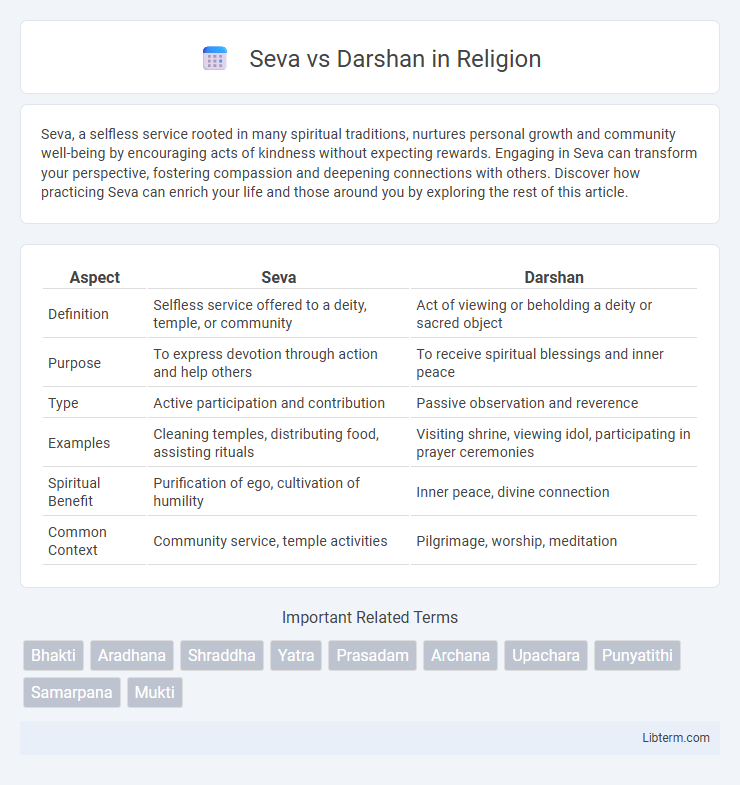Seva, a selfless service rooted in many spiritual traditions, nurtures personal growth and community well-being by encouraging acts of kindness without expecting rewards. Engaging in Seva can transform your perspective, fostering compassion and deepening connections with others. Discover how practicing Seva can enrich your life and those around you by exploring the rest of this article.
Table of Comparison
| Aspect | Seva | Darshan |
|---|---|---|
| Definition | Selfless service offered to a deity, temple, or community | Act of viewing or beholding a deity or sacred object |
| Purpose | To express devotion through action and help others | To receive spiritual blessings and inner peace |
| Type | Active participation and contribution | Passive observation and reverence |
| Examples | Cleaning temples, distributing food, assisting rituals | Visiting shrine, viewing idol, participating in prayer ceremonies |
| Spiritual Benefit | Purification of ego, cultivation of humility | Inner peace, divine connection |
| Common Context | Community service, temple activities | Pilgrimage, worship, meditation |
Introduction to Seva and Darshan
Seva refers to selfless service performed without expecting any reward, often involving acts of helping others or participating in community welfare, embodying the principle of altruism in spiritual practice. Darshan is the sacred act of seeing and being seen by a deity or a revered person, considered a form of divine blessing and spiritual connection in Hinduism and other Indian religions. While Seva emphasizes active participation and service, Darshan centers on devotion and the visual communion with the divine.
Defining Seva: Meaning and Significance
Seva, derived from Sanskrit meaning selfless service, involves acts performed without expecting rewards, symbolizing devotion and humility in spiritual contexts. It holds significant importance in many religious traditions, emphasizing altruism and community support as a path to personal growth and spiritual enlightenment. Unlike Darshan, which focuses on the act of viewing a deity or holy person, Seva actively engages the devotee in service, fostering deeper connection and spiritual merit.
Understanding Darshan: Concept and Importance
Darshan, derived from the Sanskrit word meaning "sight" or "vision," refers to the auspicious act of seeing and being seen by a deity, guru, or sacred object in Hinduism and other Indian religions. This sacred interaction fosters a spiritual connection, allowing devotees to receive divine blessings and experience inner peace and devotion. Understanding Darshan is crucial as it emphasizes the reciprocal nature of the divine encounter, reinforcing faith and elevating the worshipper's spiritual consciousness.
Historical Roots of Seva and Darshan
Seva, rooted in ancient Indian spiritual traditions, emphasizes selfless service as a path to divine connection and community welfare, often documented in Vedic scriptures and Bhakti literature. Darshan, meaning "auspicious sight," originates from classical Hindu temple culture, where beholding a deity's image is believed to confer blessings and spiritual merit. Both practices, integral to Hindu worship, evolved over centuries to embody distinct yet complementary modes of devotion, reflecting the dynamic relationship between active service and contemplative observation in spiritual life.
Key Differences Between Seva and Darshan
Seva involves active participation and selfless service to deities or the community, emphasizing personal effort and dedication. Darshan, on the other hand, centers on the sacred act of viewing a deity or holy person, focusing on spiritual connection without physical involvement. The key difference lies in Seva's action-oriented approach versus Darshan's contemplative experience.
Spiritual Benefits of Seva
Seva, the selfless service performed without expectation of reward, cultivates humility, compassion, and inner peace by actively engaging devotees in spiritual practice. Unlike Darshan, which involves the passive act of viewing a deity or holy person, Seva deepens spiritual growth through direct action and personal sacrifice. Engaging in Seva creates positive karma, purifies the mind, and fosters a profound connection with the divine, promoting lasting transformation beyond the momentary blessings of Darshan.
Spiritual Impact of Darshan
Darshan, in Hindu spiritual practice, involves the visual connection with a deity or a revered person, which creates a powerful channel for divine energy to flow to the devotee. Unlike Seva, which emphasizes selfless service, Darshan facilitates an immediate spiritual upliftment and deepens the devotee's faith and devotion through the direct experience of sacred presence. This visual communion often sparks inner transformation, fostering spiritual growth and a profound sense of peace.
Practical Examples: Seva vs Darshan in Temples
Seva in temples involves active participation, such as offering food, cleaning the shrine, or assisting priests, embodying selfless service that deepens spiritual connection. Darshan, on the other hand, is the act of viewing the deity or sacred object, often experienced during rituals like the morning Aarti or festival celebrations, to receive divine blessings. Both practices complement each other, with Seva fostering devotion through action and Darshan providing a moment of spiritual reflection and reverence.
Seva and Darshan in Modern Spirituality
Seva and Darshan play crucial roles in modern spirituality by fostering a direct, experiential connection with the divine through service and observation. Seva, or selfless service, emphasizes active participation in spiritual growth by helping others without expectation, reinforcing compassion and humility as core values. Darshan, the act of beholding a holy person or sacred object, offers a moment of spiritual insight and blessing, bridging the gap between the devotee and the divine presence.
Choosing Between Seva and Darshan: Which Suits You?
Choosing between Seva and Darshan depends on whether you seek active participation or contemplative observation in your spiritual practice. Seva, involving selfless service, offers a hands-on experience that fosters humility and connection through meaningful actions. Darshan emphasizes witnessing the divine presence, appealing to those who find inspiration and peace in devotional observation and spiritual absorption.
Seva Infographic

 libterm.com
libterm.com